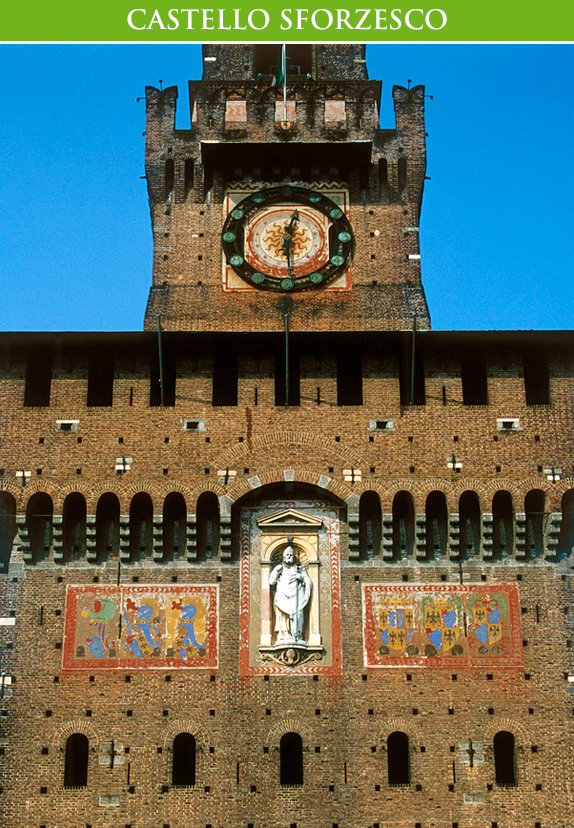
Castello Sforzesco
This massive, sun-baked rectangular bastion in Milan is actually a complex of fortresses, castles and towers begun in 1451 for Francesco Sforza, largely restored in 1893–1904, and again after massive World War II damage. Its many collections include art and sculpture from the early Middle Ages to the 18th century, decorative arts, musical instruments, Oriental art, and archaeology.
 Piazza Castello, Milan • 02 8846 3700 • www.milanocastello.it • 9am–7pm daily (6pm winter) • free
Piazza Castello, Milan • 02 8846 3700 • www.milanocastello.it • 9am–7pm daily (6pm winter) • free
 Musei Civici • 02 8846 3703 • 9am–5:30pm Tue–Sun • adm €3 (free from 2pm Fri and for under-18s)
Musei Civici • 02 8846 3703 • 9am–5:30pm Tue–Sun • adm €3 (free from 2pm Fri and for under-18s)
1. Michelangelo’s Rondanini Pieta
Michelangelo started his career with a Pietà carved at the age of 25 (now in St Peter’s, Rome) and, while the master was famous for not finishing his statues, in this instance it was not his fault. At the age of 89, in 1564, he was struck down (probably by a stroke) literally while chipping away at this sculpture.
2. Funerary Monument for Gaston de Foix
Gaston de Foix was Duke of Nemours, Marshall of France, ruler of the French Milan Duchy, posthumous hero of the 1512 Battle of Ravenna and Louis XII’s nephew. His tomb’s ethereally sculpted elements, carved by Bambaia in 1510, are now dispersed (for further details see Gaston de Foix’s Tomb).
3. Sala delle Asse
The “Plank Hall” was decorated in 1498 by Leonardo da Vinci with a trompe l’oeil arbour of geometrically intricate vines on the vaulted ceiling. This was painted over many times; the only bit we can be sure is original is a monochrome sketch of a twisting root, on the wall between the two windows.
4. Mantegna’s Madonna in Glory
Bellini’s famous brother-in-law painted this magnificent altarpiece for a Verona church in 1497, making it one of his final works. The harshness of his youthful style is tempered by age and experience to yield this solid, naturalistic approach.
5. Bellini’s Madonna and Child
This is an early Bellini, painted 1468–70, with touching detail. Mary wears a pearl-trimmed pink shawl. Jesus gazes at a lemon in his hand.
6. Bellini’s Poet Laureate
The attribution of this portrait, painted in 1475, has wavered between Bellini and Antonella da Messina. There is an almost Flemish attention to detail in the hair and eyes of the subject.
7. Bronzino’s Lorenzo Lenzi
A Mannerist painter at the Medici court in Florence, Bronzino’s delicate portrait shows a sensitivity to his subject’s youthful restlessness.
8. Trivulzio Tapestries
The Tapestries of the Twelve Months were designed by Bramantino in 1503 and named for the man who commissioned them, General Gian Giacomo Trivulzio.
9. Cappella Ducale
The Ducal chapel has the original frescoes painted in 1472 by Stefano de Fedeli and Bonifacio Bembo for Galeazzo Maria Sforza, including a Resurrection and an Annunciation.
10. Parco Sempione
The 47-hectare (115-acre) park northwest of the castle is central Milan’s largest green space. A public park since 1893, many of its structures are fine early 20th-century Art Nouveau (for further details see Parco Sempione).
Gaston de Foix’s Tomb
In 1510, King Francis I ordered a tomb for the hero. Bambaia sculpted an effigy of the warrior, lying in state, and high-relief panels. When the French pulled out of Milanese affairs in 1522, the tomb was unfinished. Pieces of it were sold off, winding up here, in the Ambrosiana (for further details see Bambaia’s Detail from the Tomb of Gaston de Foix), in Turin and in London.
 Tip: Ask about special tours that can get you into many non-museum sections of the castle that are normally closed to the public.
Tip: Ask about special tours that can get you into many non-museum sections of the castle that are normally closed to the public. Tip: The snack vans on-site are overpriced, and the nearest bars are best avoided. Head down Via Dante to the café at No. 15, where you can enjoy panini and gelato.
Tip: The snack vans on-site are overpriced, and the nearest bars are best avoided. Head down Via Dante to the café at No. 15, where you can enjoy panini and gelato.


